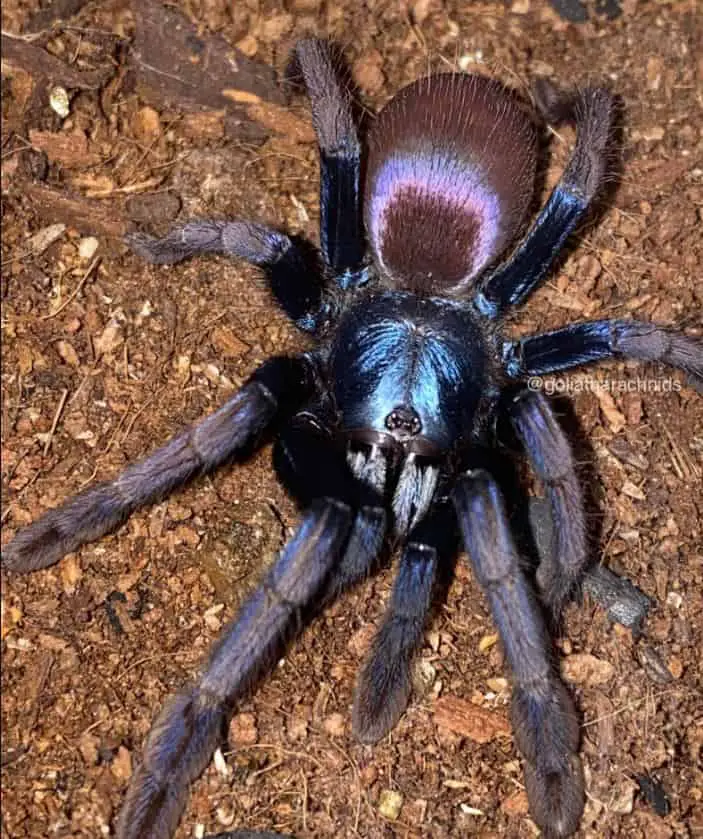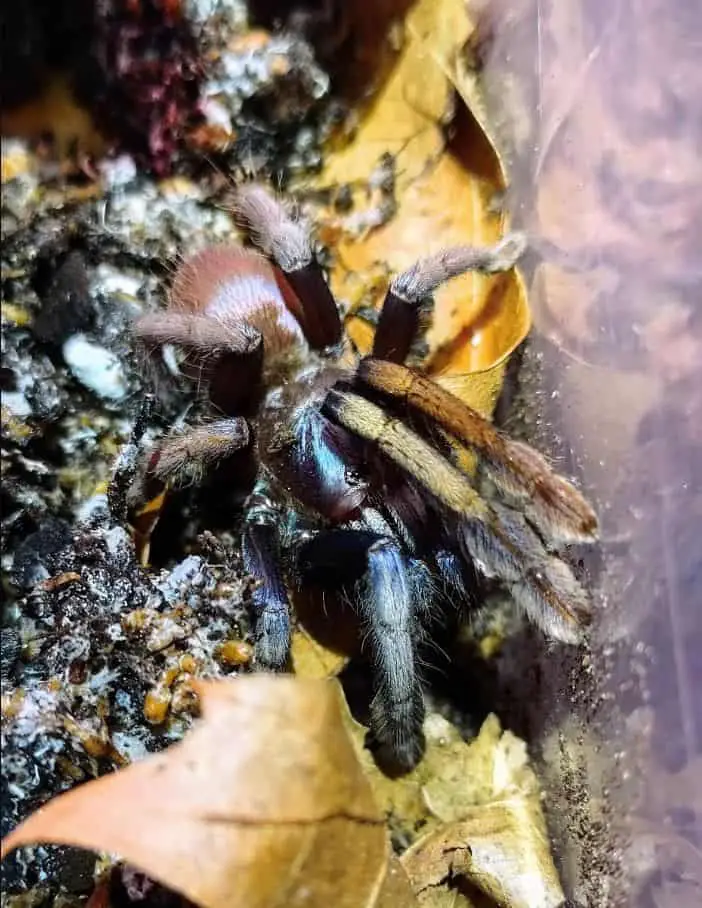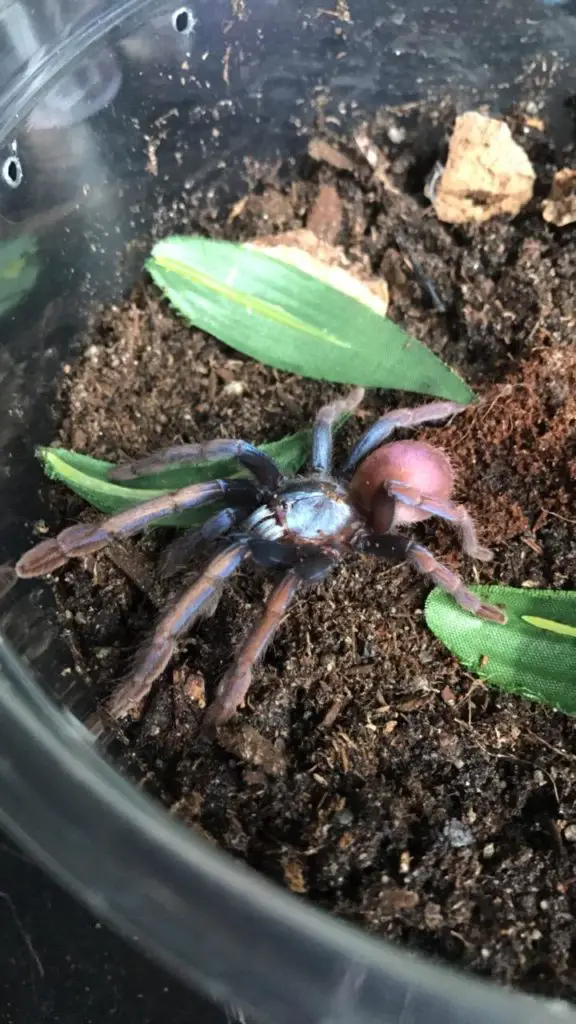The Indian Rainbow Tarantula (Haploclastus devamatha) is an Old World terrestrial species from India. More specifically, they’re from the Western Ghats region, which has been studied by the Deva Matha College in Kuravilangad for around four years.
Extremely attractive due to its metallic sheen and colorful display, it’s really popular amongst hobbyists. The species’ fancy colors are one of the reasons why it is amongst the most expensive tarantulas on the market.
If you’re considering adding the magnificent Indian Rainbow Tarantula to your collection, here’s everything you need to know!

Indian Rainbow Tarantula Care Sheet
| Species Name | Haploclastus devamatha |
| Family Name | Theraphosidae |
| Common Names | Indian Rainbow Tarantula |
| Category | Old World |
| Type | Terrestrial Burrower, Fossorial |
| Native Location | India, Western Ghats |
| Body length | 2 inches (~5 cm) |
| Leg Span | 4.3 inches (~11 cm) |
| Growth Speed | Fast |
| Urticating Hairs | No |
| Social | Solitary |
| Diet | Insects: primarily crickets and roaches |
| Temperature | 75 to 82 degrees Fahrenheit |
| Humidity | 60 to 70% |
| Lifespan | Female: 12 to 15 years / Male: 2 to 4 years |
| Experience required | Intermediate – Advanced |
| Minimum tank size | 12″ x 8″ x 8″ |
Indian Rainbow Tarantula Overview
The Haploclastus devamatha, previously known as Thrigmopoeus psychedelicus, has earned a few nicknames over the years like “LSD Earth Tiger” or “Polychromatic Earth Tiger.”
However, by far the most popular name for this species amongst keepers is the Indian Rainbow Tarantula (IRT), thanks to her prismatic color display.
Being particularly small for an Old World species, she tends to exhibit defensive and twitchy behavior. This temperament is why it’s not a recommended fit for beginners.
Careless handling can make you victim to her venom, which is reported to be really painful.
This is a terrestrial fossorial species, which means that they spend their time on the ground rather than in the trees and that they dig to create burrows.
Appearance & Variants

The Indian Rainbow Tarantula excels in mesmerizing keepers with her beautiful set of colors. In her first stages of development, she usually seems like your average brown-looking spiderling. However, as she matures, she develops a metallic and reflective sheen that goes around her femur and carapace.
The colors are primarily blue tones depending on the light’s angle, with a more metallic violet-looking abdomen. They’re known for having two different forms, a pink version that displays a more pink/grape metallic tone in her abdomen and a blue version that keeps the blue shade all over their body.
They’re a relatively small species, topping out at a size of about 4 inches.
There’s no particular difference between males and females other than size. As is standard with arachnids, females are larger than males.
The only reliable way to determine whether you have a male or female on your hand is through the examination of the inside of their molts.
Price
The cost of these spiders depends on whether you’re buying a male or a female. It’s an exotic and expensive species, with spiderlings going up to around $100 each.
Adult males can be bought for $200.
Due to their longer lifespan and larger size, adult females typically sell for between $500 and $700.
To prevent supporting poachers make sure to buy it from a reputable vendor that sells captive-bred specimens.
Behavior and Temperament
The Indian Rainbow Tarantula is a fossorial species. She excels at digging relatively deep burrows against mud banks or at the base of trees and shrubs.
She builds unbranched burrows lined with silk in these locations. They have a single entrance, which is a circular opening ornamented with dried leaves pasted together using silk to form a short turret.
Given that she spends most of her time inside her burrow, it’s advisable to use plenty of substrate. Most of the time, you’ll only see her legs at her burrow’s entrance as she waits to catch her meal.
However, the time she does spend outside of her burrow is worth the wait due to her magnificent coloration.
Furthermore, since tarantulas have a tendency to create burrows near the sides of the enclosure, it’s very possible that you’ll be able to see inside the burrow through the glass, which can make for an interesting viewing experience. Nevertheless, do be prepared that this species is often described as a “pet hole” because of how much time they will spend in their burrow.
This is a very fast and defensive spider, and its twitchy behavior can often result in a threat pose that will evolve into an attack with short provocation.
Owners must be careful when interacting with them as their venom is very painful.
Due to their defensive behavior, they’re not recommended for beginners.
Caring for an Indian Rainbow Tarantula

Temperature and Humidity
The Indian Rainbow Tarantula likes muddy weather, so she stays close to tropical areas. She’s used to temperatures of 75°F to 78°F during the Winter and 78°F to 82°F in Summer; with a humidity of 60% to 70%.
Ventilation is also important to avoid the growth of mold or bacteria.
Substrate
The Indian Rainbow Tarantula is a terrestrial and fossorial burrower. She’s most comfortable in burrows that go deep underground.
You should provide around four inches of substrate for spiderlings and juveniles and at least six inches for adults.
She needs a soft substrate for burrowing, so a mixture of peat moss and coconut fiber works well for her.
Tank
Adults should be kept in a fossorial setup with at least four times the size of the spider (12″ x 8″ x 8″) in horizontal space, making enough room for her substrate and burrows.
Find plenty of debris for her to build her turret and place some ornaments at the entrance. Possible decorative ornaments and debris include small rocks, leaves, and moss.
Remember that she shouldn’t have too much space to climb. As a fossorial spider, most of the tank’s vertical space must be used for the substrate.
Watering
As long as you maintain a water dish inside the tank, and refill it as soon as it gets empty, the Indian Rainbow Tarantula will be hydrated.
The plate should be kept away from the turret, or else the IRT will use it as a building material, making it hard to handle and refill it.
The substrate should be watered at least once a month so the substrate stays soft for the burrowing process. Be mindful as you spray; you only need to keep the soil moist, not soak it.
Social
The Indian Rainbow Tarantula is not a social species and should be housed solitarily. Housing them communally will lead to cannibalism.
Diet and Feeding
The Indian Rainbow Tarantula should eat a diet that consists of insects.
Spiderlings should be fed a flightless fruit fly twice a week. Once they reach half an inch, you can start feeding them with one or two small crickets per week.
Juveniles could eat two medium crickets or one small roach every seven to ten days.
Adults should be fed a larger roach or four to five adult crickets every ten to fourteen days.
Make sure to check after you feed them and remove any uneaten food they may have left to avoid the growth of mold, bacteria, and spider mites.
Take into account that her burrows are pretty deep, so it may take her some time to go out and eat.
Lifespan & Health
The Indian Rainbow tarantula has an average lifespan of 12 to 15 years for females and 2 to 4 years for males. To keep them healthy, make sure that you remove uneaten food, provide adequate ventilation & humidity, and that you do not feed them wild-caught insects.
Fun Facts about the Indian Rainbow Tarantula
- Two particular color forms have been observed in the population of H. devamatha: Pink form and Blue form.
- The H. Devamata was previously known as Thrigmopoeus psychedelicus. However, that name is now considered a junior synonym of Haploclastus devamatha, described in March of 2014.
- Its previous name, psychedelicus, corresponded to the word “psychedelic” in honor of its bright, intense colors. The nickname LSD Earth-Tiger most likely has to do with the bright colors experienced in psychedelic phenomenons.
- The specific epithet of the specie is obtained from the name of the college, Deva Matha College, Kuravilangad in India.
Final words: Is the Indian Rainbow Tarantula Right for you?
We hope this article has provided you with everything you need to know about this gorgeous tarantula. Remember that if you do choose to get one, you must use a reputable captivity-bred vendor. She’s a gorgeous spider and makes a good addition to every hobbyist’s collection.
Do note that this species is not for beginners. They’re extremely quick, very defensive, and have potent venom. This is not a good introductory spider. If you’ve never owned a tarantula before, you’re better off getting your feet wet with a more docile species such as the Mexican Red Rump or Arizona Blonde first.
- How Long Do American Eskimo Dogs Live? Important Factors and Care Tips - September 29, 2023
- Do American Bulldogs Need Grooming? Essential Tips and Care Guidelines - September 29, 2023
- Do Bengal Cats Enjoy Playing? Essential Tips for Keeping Them Active - September 29, 2023